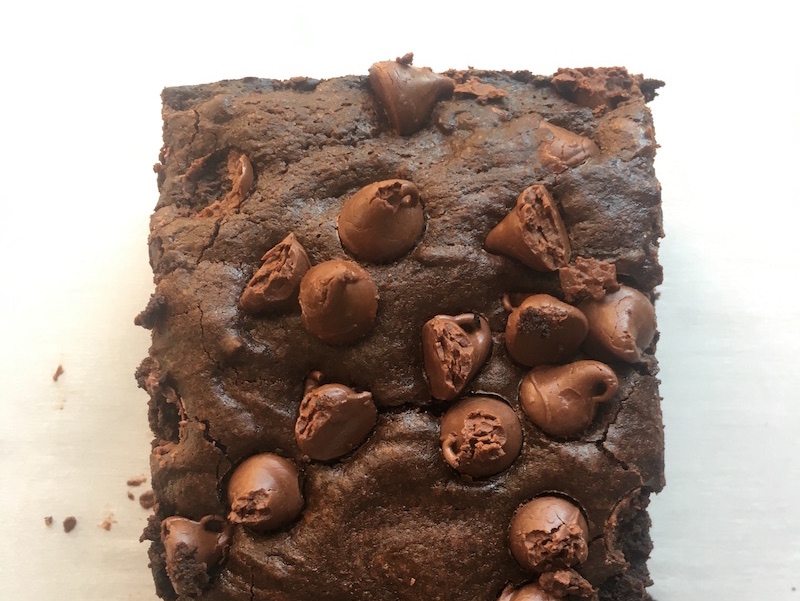There’s something incredibly comforting this time of year (or anytime for that matter) about a warming bowl of dal. The combination of herbs and spices (asafoetida, turmeric, chile powder, cumin seeds, garam masala, and curry leaves) along with fresh ingredients (onions, tomatoes, fresh ginger, and garlic) make this dish come alive.
I made this easy Indian dal, a combination of chana dal (split chickpeas) and toor/toovar dal (split pigeon peas) for dinner the other night; and then I made it again the following night. It’s so simple, but oh-so satisfying. My husband and I agreed, we should eat dal more often. It’s understandable why dal is a staple of Indian cooking. It’s vegetarian (vegan, if you substitute oil for ghee), nourishing, inexpensive, healthy, protein-rich, and, most important, delicious — a harmonious balance of herbs and spices.


The term dal, dahl, or daal refers to a dried pulse/legume (lentils, beans, or peas) that has been split. Dal also refers to an Indian legume dish that has been simmered and, usually, pureed and spiced. Dal is a principal dish in India’s rich culinary history. The variety of dal dishes is so vast, differing from region to region, that you could make a different dal every day and not repeat for months.
Dal Fry is a popular Indian dish that features cooked lentils tempered with spices and aromatics. It’s a staple in Indian cuisine, known for its comforting and hearty qualities. Here are some key characteristics:
- Base Ingredients: The primary ingredient is dal, which can include any variety of lentils, such as toor dal (split pigeon peas), masoor dal (red lentils), or moong dal (split green gram). The lentils are boiled until tender.
- Tempering (Tadka): The distinctive feature of Dal Fry is the tadka or tempering. This involves heating oil or ghee and frying spices such as cumin seeds, mustard seeds, asafoetida (hing), garlic, ginger, and dried red chilies. This spice-infused oil is then mixed into the cooked lentils, infusing them with rich flavors.
- Additional Flavors: Along with the spices, ingredients like onions, tomatoes, green chilies, and sometimes herbs like cilantro are sautéed in the tadka, adding depth to the dish.
- Consistency: Dal Fry usually has a medium to thick consistency, making it perfect to be scooped up with Indian breads like roti or naan, or served alongside rice.
- Regional Variations: While the basic concept of Dal Fry remains consistent, there are regional variations across India. Each region may use different types of lentils and spice combinations, leading to a diverse range of flavors under the umbrella of Dal Fry.
- Nutrition: Lentils are a great source of protein, especially for vegetarians and vegans. The dish is also rich in fiber and essential nutrients, making it a healthy and filling choice.

The dal is cooked separately in a pot (or pressure cooker) with water for about 30 minutes until it thickens and becomes tender. While the dal is cooking, you can make the dal fry — the spices, herbs, garlic, ginger, tomatoes, and onions are fried in oil or ghee — that will eventually be poured over the cooked dal.
And you’ll want to serve with rice or flatbread to scoop up the dal.
I made some methi (fenugreek) paratha (Indian flatbread) to accompany my dal. I took a trip to my favorite Indian grocery store, Patel Brothers, to hunt down fresh fenugreek; 30 minutes later, walked out with a bag full of ingredients: multigrain flour for my paratha, curry leaves, chiles, an array of spices, ginger, several varieties of dal, a big bag of rice, and, yes, fresh fenugreek.



The flavor of fresh fenugreek is elusive to describe — mild, slightly bitter, herbaceous. Nonetheless, it lends a unique and welcome flavor to the paratha. If you can’t find fresh fenugreek, you can substitute with something like spinach, though the resulting paratha will lack that ‘something’ that fenugreek imparts. If you have access to an Indian grocery store, fresh fenugreek (and curry leaves) is definitely worth seeking out. I also like to add fresh fenugreek to saag paneer.
What if I can’t get all these Indian ingredients?
No worries!
To adapt the Indian Dal Fry and Spiced Bread recipe for ingredients more commonly found in US grocery stores, here are some alternative suggestions:
Dal Fry:
- Toor Dal: Replace with yellow split peas or red lentils. Both are more widely available and cook in a similar way to toor dal.
- Chana Dal: Substitute with yellow split peas or additional red lentils.
- Asafoetida (Hing): This ingredient might be tough to find. A mix of minced garlic and a pinch of onion powder can be used as a substitute, though the flavor will be different.
- Curry Leaves: While not a perfect substitute, a combination of bay leaves and a squeeze of lemon juice can add a similar fragrant and tangy note.
- Garam Masala: This spice blend is becoming increasingly common in US grocery stores, but if you can’t find it, you can make a simple version by mixing ground cumin, coriander, cardamom, and cloves.
Methi (Fenugreek) Paratha Flatbread:
- Wheat Atta Flour: Substitute with whole wheat flour or a mix of whole wheat and all-purpose flour.
- Fresh Fenugreek: As suggested, spinach is a great alternative. Kale can also work if you’re looking for a more robust flavor.
- Green Chile: Any mild green chili available in your local store, like jalapeno, can be used. Adjust the quantity based on your heat preference.
The essence of this dish is in the combination of spices and the method of preparation. While the substitutes may not replicate the authentic taste perfectly, they will still result in a delicious meal that captures the spirit of the original recipes.

Indian Dal Fry with Spiced Flatbread
- Total Time: 1 hour 30 minutes
- Yield: 2-4 servings 1x
Description
There’s something incredibly comforting about a warming bowl of dal. The combination of herbs and spices along with fresh ingredients make this dish come alive.
Ingredients
- 1/2 cup Toor Dal (Split Pigeon Peas)
- Alternative: Yellow Split Peas or Red Lentils
- 1/2 cup Chana Dal (Split Chickpea or Bengal Gram)
- Alternative: Yellow Split Peas or additional Red Lentils
- 3 tablespoons Ghee and/or Oil
- Pinch of Asafoetida (Hing)
- Alternative: Minced Garlic and a pinch of Onion Powder
- 1 teaspoon Cumin Seeds
- 1/2 teaspoon Ground Turmeric
- 1/2 teaspoon Chile Powder
- 5 to 6 Curry Leaves
- Alternative: Bay Leaves and a squeeze of Lemon Juice
- 1 medium Onion, chopped
- 1 medium Tomato, chopped
- 1 Green Chile, split in half lengthwise or finely chopped (seeded for less heat if desired)
- 1 teaspoon Freshly Grated Ginger
- 1 teaspoon Freshly Grated Garlic
- Salt, to taste
- 1 teaspoon Garam Masala
- Note: Available in most US grocery stores; can be made by mixing ground Cumin, Coriander, Cardamom, and Cloves.
- Handful of Cilantro Leaves, for garnish
For Methi (Fenugreek) Paratha Flatbread:
- 1 cup Wheat Atta Flour
- Alternative: Whole Wheat Flour or a mix of Whole Wheat and All-Purpose Flour
- Olive Oil
- 1/2 cup tightly packed chopped Fresh Fenugreek
- Alternative: Spinach or Kale
- 2 Garlic Cloves, crushed to a paste
- 1 Green Chile, minced
- 1/4 teaspoon Cumin Seeds
- 1/8 teaspoon Ground Turmeric
- Salt, to taste
Instructions
- Wash the lentils well in a sieve with cold running water until the water runs clear. Bring to a boil with 2 1/2 cups of water. Reduce heat and simmer for 30 minutes until the mixture resembles a thick soup, adding more hot water as needed (1/2 cup at a time).
- Heat the ghee and/or oil in a saucepan or skillet over medium heat. When hot, add a pinch of asafoetida, cumin seeds, chile powder, turmeric, and curry leaves. As the spices sizzle, reserve a teaspoon of the red oil for garnish. Add the onions. Sauté for five minutes until the onions are soft. Add the tomatoes, green chile, ginger, and garlic, and saute for another five minutes. Add salt to taste. Add the spice-onion mixture to the dal and stir to combine.
- Take off the heat and add the garam masala.
- Transfer to a serving bowl, drizzle over the reserve chile oil and fresh cilantro.
For the Flatbread:
- Place flour in a large mixing bowl.
- Heat 2 teaspoons oil in a skillet over medium heat. Fry the cumin until aromatic, about 2 minutes (watch carefully making sure it doesn’t burn). Add the garlic and chile, and fry another 30 seconds. Add the chopped fenugreek (or spinach) and turmeric, and fry a minute or two until it wilts. Remove from the heat and add to the bowl of flour. Season with salt. Stir to combine.
- Add 1/2 cup of water, little by little, stirring to combine. Continue to add water a tablespoon at a time until the dough is smooth and pliable. Cover and lest rest 30 minutes.
- Divide the dough into five equal balls. Lightly flour a work surface and, using a rolling pin, roll out the dough until thin, approximately 7-inches in diameter.
- Heat a medium skillet over medium heat. Brush the dough with oil and add to the skillet, oil-side down. Brush the top with oil. Cook until lightly brown, 30 to 40 seconds, flip, and then cook on the other side until lightly brown and cooked through. Cover the paratha with a clean tea towel to keep warm.
Notes
To adapt the Indian Dal Fry and Spiced Bread recipe for ingredients more commonly found in US grocery stores, here are some alternative suggestions:
Dal Fry:
- Toor Dal: Replace with yellow split peas or red lentils. Both are more widely available and cook in a similar way to toor dal.
- Chana Dal: Substitute with yellow split peas or additional red lentils.
- Asafoetida (Hing): This ingredient might be tough to find. A mix of minced garlic and a pinch of onion powder can be used as a substitute, though the flavor will be different.
- Curry Leaves: While not a perfect substitute, a combination of bay leaves and a squeeze of lemon juice can add a similar fragrant and tangy note.
- Garam Masala: This spice blend is becoming increasingly common in US grocery stores, but if you can’t find it, you can make a simple version by mixing ground cumin, coriander, cardamom, and cloves.
Methi (Fenugreek) Paratha Flatbread:
- Wheat Atta Flour: Substitute with whole wheat flour or a mix of whole wheat and all-purpose flour.
- Fresh Fenugreek: As suggested, spinach is a great alternative. Kale can also work if you’re looking for a more robust flavor.
- Green Chile: Any mild green chili available in your local store, like jalapeno, can be used. Adjust the quantity based on your heat preference.
The essence of these dishes is in the combination of spices and the method of preparation. While the substitutes may not replicate the authentic taste perfectly, they will still result in a delicious meal that captures the spirit of the original recipes.
- Prep Time: 30 min
- Cook Time: 60 mins
- Category: Main
- Method: Frying
- Cuisine: Indian
























Great dal and I loved the bread too.
Lovely!!!! Nicely done. Tasty and suthentuc